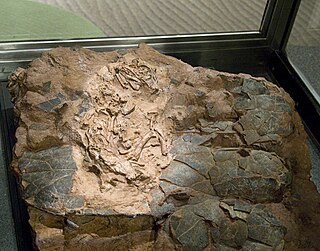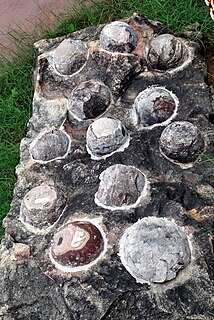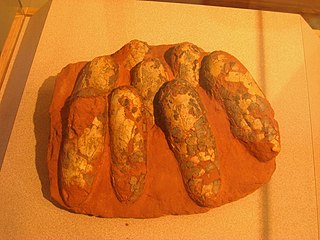
Elongatoolithus is an oogenus of dinosaur eggs found in the Late Cretaceous formations of China and Mongolia. Like other elongatoolithids, they were laid by small theropods, and were cared for and incubated by their parents until hatching. They are often found in nests arranged in multiple layers of concentric rings. As its name suggests, Elongatoolithus was a highly elongated form of egg. It is historically significant for being among the first fossil eggs given a parataxonomic name.
Dictyoolithus is an oogenus of dinosaur egg from the Cretaceous of China. It is notable for having over five superimposed layers of eggshell units. Possibly, it was laid by megalosauroid dinosaurs.

Macroelongatoolithus is an oogenus of large, fossil theropod eggs. They are known from Asia and from North America.

Macroolithus is an oogenus of dinosaur egg belonging to the oofamily Elongatoolithidae. The type oospecies, M. rugustus, was originally described under the now-defunct oogenus name Oolithes. Three other oospecies are known: M. yaotunensis, M. mutabilis, and M. lashuyuanensis. They are relatively large, elongated eggs with a two-layered eggshell. Their nests consist of large, concentric rings of paired eggs. There is evidence of blue-green pigmentation in its shell, which may have helped camouflage the nests.
Phaceloolithus is an oogenus of dinosaur egg found in the Dongting basin of the Hunan Province of China. The eggs have a subspherical shape, measuring up to 168 mm on the long axis, and having a very thin shell.
Continuoolithus is an oogenus of dinosaur egg found in the late Cretaceous of North America. It is most commonly known from the late Campanian of Alberta and Montana, but specimens have also been found dating to the older Santonian and the younger Maastrichtian. It was laid by an unknown type of theropod. These small eggs are similar to the eggs of oviraptorid dinosaurs, but have a distinctive type of ornamentation.
Ageroolithus is an oogenus of dinosaur egg. It may have been laid by a theropod.
Dispersituberoolithus is an oogenus of fossil egg, which may have been laid by a bird or non-avian theropod.

Egg fossils are the fossilized remains of eggs laid by ancient animals. As evidence of the physiological processes of an animal, egg fossils are considered a type of trace fossil. Under rare circumstances a fossil egg may preserve the remains of the once-developing embryo inside, in which case it also contains body fossils. A wide variety of different animal groups laid eggs that are now preserved in the fossil record beginning in the Paleozoic era. Examples include invertebrates like ammonoids as well as vertebrates like fishes, possible amphibians, and reptiles. The latter group includes the many dinosaur eggs that have been recovered from Mesozoic strata. Since the organism responsible for laying any given egg fossil is frequently unknown, scientists classify eggs using a parallel system of taxonomy separate from but modeled after the Linnaean system. This "parataxonomy" is called veterovata.
Sankofa is an oogenus of prismatoolithid egg. They are fairly small, smooth-shelled, and asymmetrical. Sankofa may represent the fossilized eggs of a transitional species between non-avian theropods and birds.
Paraelongatoolithus is a late Cretaceous oogenus of Chinese fossil egg, classified in the oofamily Elongatoolithidae, which represents the eggs of oviraptorosaurs.

Elongatoolithidae is an oofamily of fossil eggs, representing the eggs of oviraptorosaurs. They are known for their highly elongated shape. Elongatoolithids have been found in Europe, Asia, and both North and South America.
Guegoolithus is an oogenus of fossil egg from the early Cretaceous of Spain. It is classified in the oofamily Spheroolithidae, and was probably laid by an ornithopod dinosaur.
Undulatoolithus is an oogenus of Chinese fossil dinosaur egg belonging to Elongatoolithidae. It is very similar to Macroolithus, but has different ornamentation. Like other elongatoolithids, it was probably laid by oviraptorosaurs.
Tubercuoolithus is an oogenus of dinosaur egg from the early Campanian of Montana.
Triprismatoolithus is an oogenus of dinosaur egg native to Teton County, Montana. It is classified in the oofamily Arriagadoolithidae, the eggs of alvarezsaurs.
Trigonoolithus is an oogenus of dinosaur egg, representing a basal prismatoolithid. Its eggshell, like avian eggs, is composed of three structural layers, but cladistic analysis suggests that its parent was a non-avian theropod.

Gobioolithus is an oogenus of fossil bird egg native to Mongolia. They are small, smooth-shelled, and elongated eggs that were first discovered in the 1960s and early 70s during a series of fossil-hunting expeditions in the Gobi desert. Two oospecies have been described: Gobioolithus minor and G. major. The eggs were probably laid in colonial nesting sites on the banks of rivers and lakes.
Arriagadoolithus is the oogenus of fossil eggs which includes the eggs of the alvarezsaurid Bonapartenykus. Fossils of the creature were found in Patagonia; it may have brooded on its eggs.
Nanhsiungoolithus is an oogenus of dinosaur egg from the late Cretaceous of China. It belongs to the oofamily Elongatoolithidae, which means that it was probably laid by an oviraptorosaur, though so far no skeletal remains have been discovered in association with Nanhsiungoolithus. The oogenus contains only a single described oospecies, N. chuetienensis. It is fairly rare, only being know from two partially preserved nests and a few eggshell fragments.





